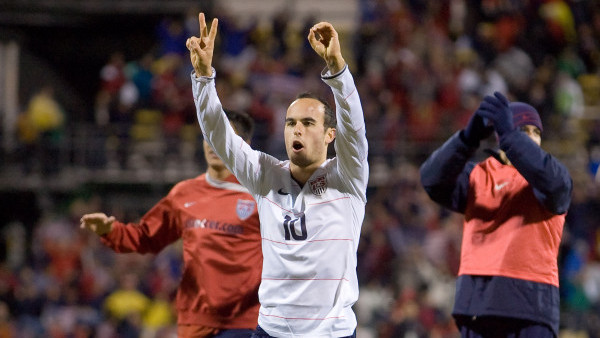Dure: We don’t need no (Academy) education?
 What’s an Academy? And what are the benefits?
What’s an Academy? And what are the benefits?
The answer depends on where you are. In some areas, “Academy” soccer refers to travel teams in the earlier ages — in Georgia, for example, it’s Under-12 and below. But the U.S. Soccer Development Academy is for older age groups, and some younger teams in their clubs may be called “pre-Academy.”
+READ: U.S. Soccer Development Academy adding U-12 level in 2016
Then there’s “Academy-style training,” which usually means combining several teams in one age group and having them go through practice together so all players get the benefit of working with the most experienced coaches in the group.
The common thread is that the “Academy” label conjures a place for learning, and most of these programs stress player development over team wins. But is the typical Academy too, well, academic? Will our soccer coaches wind up like our teachers, stressed out and handcuffed by the need to teach to some ill-conceived standardized test?
Paul Gardner is asking that question and others in a series at Soccer America:
“The new soccer leaders come with the trappings of academia. For the coaches, their multiple badges and diplomas might almost be thought to count for more than their actual coaching experience,” Gardner writes.
And Gardner, in characteristically blunt fashion, questions whether those badges and diplomas are getting results:
“If the game is really the best coach, then we need a lot more playing of the game — not supervised by adults — and a lot less of the academic approach of teaching. Teaching what, anyway? A vital part of soccer, the artistry and the creativity, cannot be taught. Just as it cannot be measured by computers. But it can be suppressed.”
+READ: U.S. Soccer Development Academy adding U-12 level in 2016
That’s not just a question for various programs labeled “Academy.” That’s a question that cuts to the heart of what coaches can and cannot do.
U.S. coaching has certainly evolved since my youth days, when I went to the Athens YMCA and had a bunch of coaches set us in positions, just as they had in gridiron football season in the fall. (The English coaches Gardner recalls from his youth sound much worse.) We may not always do what we say, but what we say is relatively consistent through the crucial 8-12 age groups — emphasize skills over tactics, emphasize development over winning, etc.
 We’re also big believers in New Age philosophies such as “positive coaching” and “guided discovery.” Coaches are no longer supposed to be sideline tyrants, micromanaging the game.
We’re also big believers in New Age philosophies such as “positive coaching” and “guided discovery.” Coaches are no longer supposed to be sideline tyrants, micromanaging the game.
But does the revved-up professionalism in youth coaching add pressure to do the opposite? Do coaches feel the need to keep up a steady stream of commentary and corrections, not necessarily development-oriented, to justify their positions?
Of course. Sure, some coaches sit back and keep quiet even when corrections seem obvious — say, when both defenders in a 2-3-1 formation are standing near the right sideline and leaving players open in the middle. But more often than that, I’m seeing coaches who are constantly instructing kids. Maybe it’s a simple reminder to switch the ball from side to side. Or maybe it’s urging a team to keep pressing the opponent’s goal kicks when the game is already a rout, because that’s such an essential part of player development.
That’s the game environment, with parents keeping one eye on the players and one eye on the person they’re paying to coach them. Training is guided by a super-serious curriculum — again, bringing academic language into something that’s supposed to be more fun than algebra.
+DURE: Can a curriculum make a youth soccer club better?
Gardner, echoing Pink Floyd in The Wall, is worried that such schooling will drum the creativity out of students, replacing it with a dull conformity. And in Europe, Gardner says, it’s not working: “I can find no convincing evidence that shows the academies to be producing more top players than the old laissez-faire system.”
So far, the results don’t look too promising in the USA, either. The U-17 residency program in Bradenton has yet to produce a Tab Ramos or a Claudio Reyna. (Landon Donovan and DaMarcus Beasley were only there for the first year of the program.) The U.S. youth teams of the Development Academy era haven’t been any better than those in the old days.

But if we don’t have evidence to show that the “Academy” ideals will turn up anything positive, nor can we prove the negative. It’s far too early to tell whether the curriculum- and Academy-bred U-12s of the last few years will turn out any better than their predecessors.
And we can see elsewhere — in Germany and in Iceland — that there’s some benefit to having more licensed coaches working with more kids.
So maybe instead of sending the kids to an Academy, we should send the coaches?
##
Beau Dure’s new book, Single-Digit Soccer: Keeping Sanity in the Earliest Ages of the Beautiful Game, is now available in paperback at Amazon and in electronic form at Amazon, Barnes and Noble, and other online booksellers. Read more about it at SportsMyriad.
SOCCERWIRE MARKETPLACE
- Start the Season Strong at Loudoun Premier Cup!
- 50th Annual Rael Vodicka Memorial Tournament
- Soccer Marketing Internships at The St. James FC
- Job Opening: The St. James FC Goalkeeper Academy Coach
- Full-Time Director of Goalkeeping for The St. James FC
- visitRaleigh.com Showcase Series 2025, hosted by NCFC Youth
- Join Official Elite Summer Soccer Camps with Europe’s Top Pro Clubs!
- OFFICIAL BAYERN MUNICH SUMMER CAMPS U.S.
- OFFICIAL FC BARCELONA CAMPS U.S.
- The Cup San Diego - Hosted by Legends FC











